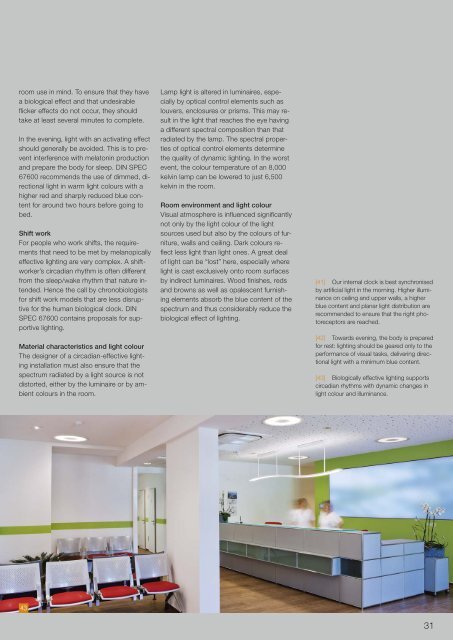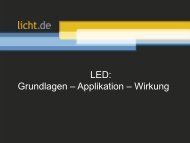licht.wissen 19 No. "Impact of Light on Human Beings"
Light synchronises our “internal clock”. Lighting that copies daylight has more than just a visual impact; it supports bodily functions 24 hours a day. Booklet 19 is intended for all those who want to delve into the topic of Impact of Light on Human Beings. The 56 pages helps to get an overview of what melanopic light can effect. Free Download at www.licht.de/en
Light synchronises our “internal clock”. Lighting that copies daylight has more than just a visual impact; it supports bodily functions 24 hours a day. Booklet 19 is intended for all those who want to delve into the topic of Impact of Light on Human Beings. The 56 pages helps to get an overview of what melanopic light can effect. Free Download at www.licht.de/en
Create successful ePaper yourself
Turn your PDF publications into a flip-book with our unique Google optimized e-Paper software.
oom use in mind. To ensure that they have<br />
a biological effect and that undesirable<br />
flicker effects do not occur, they should<br />
take at least several minutes to complete.<br />
In the evening, light with an activating effect<br />
should generally be avoided. This is to prevent<br />
interference with melat<strong>on</strong>in producti<strong>on</strong><br />
and prepare the body for sleep. DIN SPEC<br />
67600 recommends the use <str<strong>on</strong>g>of</str<strong>on</strong>g> dimmed, directi<strong>on</strong>al<br />
light in warm light colours with a<br />
higher red and sharply reduced blue c<strong>on</strong>tent<br />
for around two hours before going to<br />
bed.<br />
Shift work<br />
For people who work shifts, the requirements<br />
that need to be met by melanopically<br />
effective lighting are very complex. A shiftworker’s<br />
circadian rhythm is <str<strong>on</strong>g>of</str<strong>on</strong>g>ten different<br />
from the sleep/wake rhythm that nature intended.<br />
Hence the call by chr<strong>on</strong>obiologists<br />
for shift work models that are less disruptive<br />
for the human biological clock. DIN<br />
SPEC 67600 c<strong>on</strong>tains proposals for supportive<br />
lighting.<br />
Material characteristics and light colour<br />
The designer <str<strong>on</strong>g>of</str<strong>on</strong>g> a circadian-effective lighting<br />
installati<strong>on</strong> must also ensure that the<br />
spectrum radiated by a light source is not<br />
distorted, either by the luminaire or by ambient<br />
colours in the room.<br />
Lamp light is altered in luminaires, especially<br />
by optical c<strong>on</strong>trol elements such as<br />
louvers, enclosures or prisms. This may result<br />
in the light that reaches the eye having<br />
a different spectral compositi<strong>on</strong> than that<br />
radiated by the lamp. The spectral properties<br />
<str<strong>on</strong>g>of</str<strong>on</strong>g> optical c<strong>on</strong>trol elements determine<br />
the quality <str<strong>on</strong>g>of</str<strong>on</strong>g> dynamic lighting. In the worst<br />
event, the colour temperature <str<strong>on</strong>g>of</str<strong>on</strong>g> an 8,000<br />
kelvin lamp can be lowered to just 6,500<br />
kelvin in the room.<br />
Room envir<strong>on</strong>ment and light colour<br />
Visual atmosphere is influenced significantly<br />
not <strong>on</strong>ly by the light colour <str<strong>on</strong>g>of</str<strong>on</strong>g> the light<br />
sources used but also by the colours <str<strong>on</strong>g>of</str<strong>on</strong>g> furniture,<br />
walls and ceiling. Dark colours reflect<br />
less light than light <strong>on</strong>es. A great deal<br />
<str<strong>on</strong>g>of</str<strong>on</strong>g> light can be “lost” here, especially where<br />
light is cast exclusively <strong>on</strong>to room surfaces<br />
by indirect luminaires. Wood finishes, reds<br />
and browns as well as opalescent furnishing<br />
elements absorb the blue c<strong>on</strong>tent <str<strong>on</strong>g>of</str<strong>on</strong>g> the<br />
spectrum and thus c<strong>on</strong>siderably reduce the<br />
biological effect <str<strong>on</strong>g>of</str<strong>on</strong>g> lighting.<br />
[41] Our internal clock is best synchr<strong>on</strong>ised<br />
by artificial light in the morning. Higher illuminance<br />
<strong>on</strong> ceiling and upper walls, a higher<br />
blue c<strong>on</strong>tent and planar light distributi<strong>on</strong> are<br />
recommended to ensure that the right photoreceptors<br />
are reached.<br />
[42] Towards evening, the body is prepared<br />
for rest: lighting should be geared <strong>on</strong>ly to the<br />
performance <str<strong>on</strong>g>of</str<strong>on</strong>g> visual tasks, delivering directi<strong>on</strong>al<br />
light with a minimum blue c<strong>on</strong>tent.<br />
[43] Biologically effective lighting supports<br />
circadian rhythms with dynamic changes in<br />
light colour and illuminance.<br />
43<br />
31

















